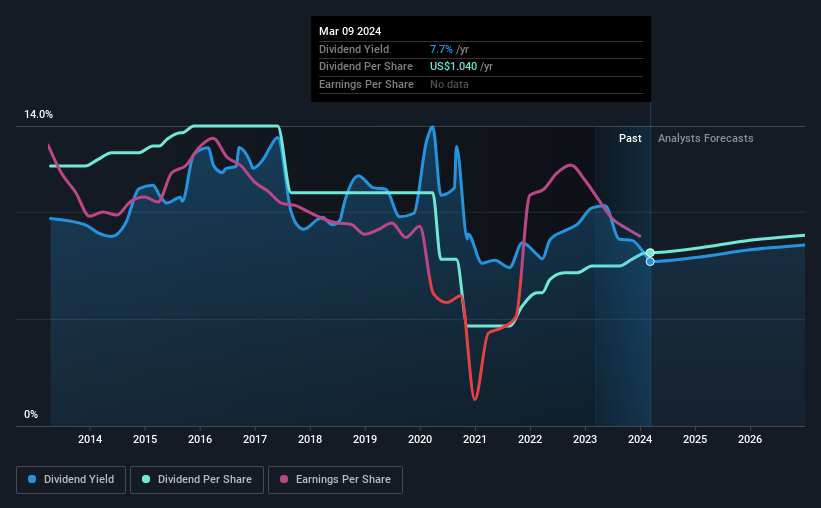Dividend Investors: Don't Be Too Quick To Buy SFL Corporation Ltd. (NYSE:SFL) For Its Upcoming Dividend
SFL Corporation Ltd. (NYSE:SFL) stock is about to trade ex-dividend in four days. The ex-dividend date is usually set to be one business day before the record date which is the cut-off date on which you must be present on the company's books as a shareholder in order to receive the dividend. It is important to be aware of the ex-dividend date because any trade on the stock needs to have been settled on or before the record date. Thus, you can purchase SFL's shares before the 14th of March in order to receive the dividend, which the company will pay on the 28th of March.
The company's next dividend payment will be US$0.26 per share, and in the last 12 months, the company paid a total of US$1.04 per share. Last year's total dividend payments show that SFL has a trailing yield of 7.7% on the current share price of US$13.55. Dividends are a major contributor to investment returns for long term holders, but only if the dividend continues to be paid. That's why we should always check whether the dividend payments appear sustainable, and if the company is growing.
See our latest analysis for SFL
Dividends are typically paid out of company income, so if a company pays out more than it earned, its dividend is usually at a higher risk of being cut. SFL distributed an unsustainably high 149% of its profit as dividends to shareholders last year. Without more sustainable payment behaviour, the dividend looks precarious. Yet cash flows are even more important than profits for assessing a dividend, so we need to see if the company generated enough cash to pay its distribution. Over the past year it paid out 156% of its free cash flow as dividends, which is uncomfortably high. It's hard to consistently pay out more cash than you generate without either borrowing or using company cash, so we'd wonder how the company justifies this payout level.
As SFL's dividend was not well covered by either earnings or cash flow, we would be concerned that this dividend could be at risk over the long term.
Click here to see the company's payout ratio, plus analyst estimates of its future dividends.
Have Earnings And Dividends Been Growing?
Stocks with flat earnings can still be attractive dividend payers, but it is important to be more conservative with your approach and demand a greater margin for safety when it comes to dividend sustainability. Investors love dividends, so if earnings fall and the dividend is reduced, expect a stock to be sold off heavily at the same time. That explains why we're not overly excited about SFL's flat earnings over the past five years. We'd take that over an earnings decline any day, but in the long run, the best dividend stocks all grow their earnings per share.
Many investors will assess a company's dividend performance by evaluating how much the dividend payments have changed over time. SFL has seen its dividend decline 4.0% per annum on average over the past 10 years, which is not great to see.
Final Takeaway
From a dividend perspective, should investors buy or avoid SFL? It's been unable to generate earnings growth, yet is paying out an uncomfortably high percentage of both its profits (149%) and cash flow (156%) as dividends. It's not the most attractive proposition from a dividend perspective, and we'd probably give this one a miss for now.
Having said that, if you're looking at this stock without much concern for the dividend, you should still be familiar of the risks involved with SFL. For example, we've found 3 warning signs for SFL (2 are significant!) that deserve your attention before investing in the shares.
Generally, we wouldn't recommend just buying the first dividend stock you see. Here's a curated list of interesting stocks that are strong dividend payers.
Have feedback on this article? Concerned about the content? Get in touch with us directly. Alternatively, email editorial-team (at) simplywallst.com.
This article by Simply Wall St is general in nature. We provide commentary based on historical data and analyst forecasts only using an unbiased methodology and our articles are not intended to be financial advice. It does not constitute a recommendation to buy or sell any stock, and does not take account of your objectives, or your financial situation. We aim to bring you long-term focused analysis driven by fundamental data. Note that our analysis may not factor in the latest price-sensitive company announcements or qualitative material. Simply Wall St has no position in any stocks mentioned.

